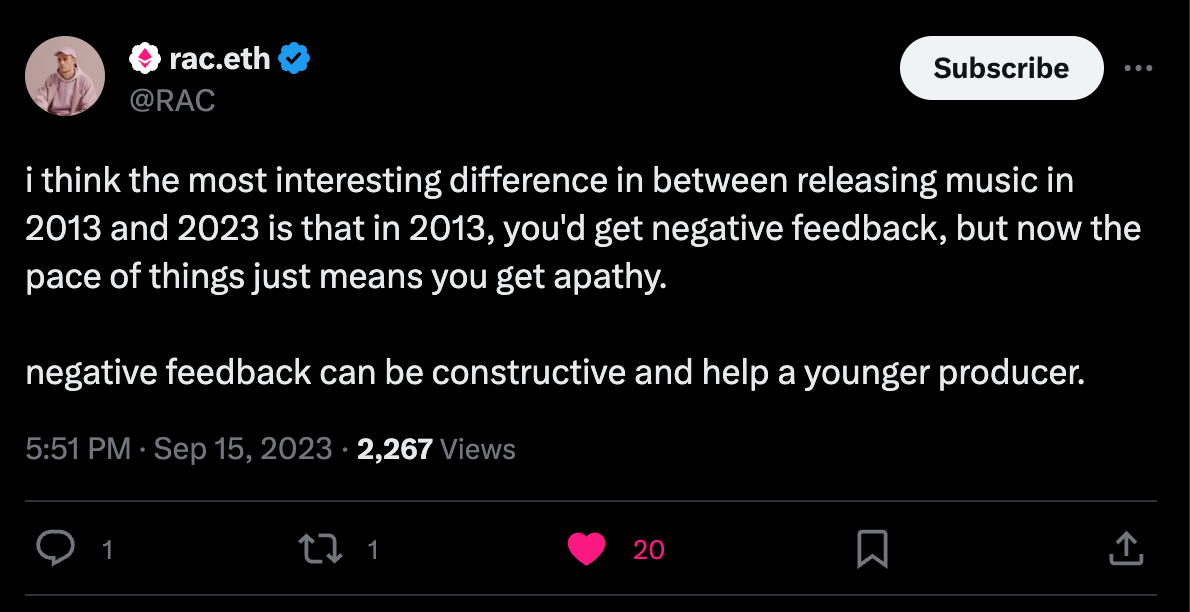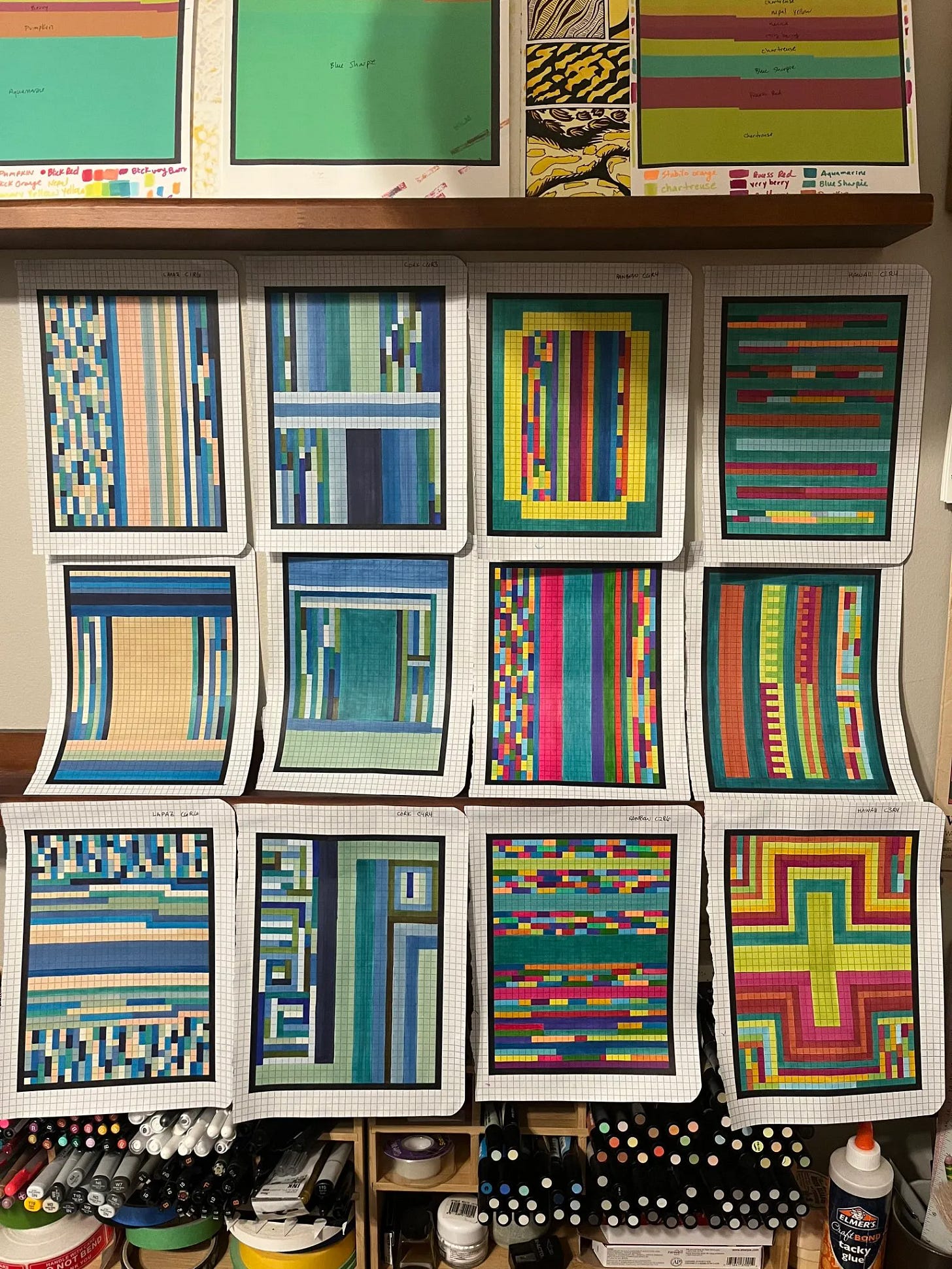Owning The Conversations: Ghost Watchers, Barbie, And Publishing in 2023
Also: Jane Jacobs vs Robert Moses, Patterns and Textiles, and a Zillow Cave
I finally watched Barbie this week when it came out on streaming and I can’t stop thinking about the current era of media abundance and the algorithm.
I loved the film. Very much a movie I enjoy. It’s wholly metamodern: being extremely self-aware and yet still finding within it a really sincere tale of belonging, meaning, play, and how we hope to make the world a better place for all of us in it. Also, growing up watching and participating in musical theater, anything with a great dance and song gets me going.
I’m late to this take, and I’m sure it’s been made before, but what I find interesting is how Mattel would okay a film critiquing them. It’s a strange balance of power that the company that wanted to make this film knew that even if they critiqued themselves, it would still result in a net positive. It’s been coming for a while, but in 2023, because there’s a huge abundance of media, owning the conversation in any capacity is worth more than potential downsides. In a way, fending off potential critique by funding your own critique drowns out the noise of legitimate critique to power. A win win: just turn up the noise.
It’s another sobering realisation that in our media abundance of today, attention is the final resource to tap. Even if it’s negative attention, it can be used to siphon off profit and value.
The burden to get on top of this froth has grown. Record labels and book publishers, for example, now ask some of their clients to get onto TikTok to stay in the frame of attention.
It’s also why brands aren’t just putting on a corporate front, but also are okay with self-effacing posts that tell us that they are “just like us”.
Thus, a lot of our online spaces have increasingly become a broadcasting channel for brands and not people.
It makes it harder to practically then do anything when having attention above all else is the winning move. It’s reminiscent of what the musician, RAC, said this week:
Thus, the best we can hope for as creators, today, is negative feedback. Apathy is the norm, even though we know that amid the brands acting like fellow people, there are lurkers.
Embedded has a great take on this:
View counts and the faces on the stories lets us know that we are being watched and yet few people care to say anything.
TikTok user Taylor Stewart has a different term for it: ghost watchers. She recently shared a video about never wanting to post anything on Instagram anymore, saying the app is now filled with these ghost watchers who never comment or reach out.
“People who watch your every move, watch everything you’re doing, but they don’t support any of it,” she described. “It’s just people watching you, and it’s just icky.”
This echoes a wider sentiment I’ve seen creeping into my personal feeds: No one really posts anymore, no one’s having fun, and it’s partly for this reason that no one seems excited about any of the newer apps and features, like Threads, that keep popping up despite everything.
I agree, as I have personally been dialing back posting on Instagram for this exact reason. It’s become unnerving.
Thus, we’ve landed in a space where most of the content we see is either brands-as-people or content packaged to the algorithmic feeds: packaged to be re-shared. Sincerity (and everyday mundanity) is gone. We’ve lost the personal web, and as Embedded mentioned → the personal web have all retreated into cozy corner group chats. It’s as if the attention monster chased us all back into caves.
But… Is it all that bad? One one side, the fact that it’s beneficial to own all the attention and the entire conversation, is demoralising. It feels that we’re losing a legitimate sense of power balance in media. Increasingly, creations that thrive only do so when they can ALSO own the conversation.
But, on the other side. It’s not truly as bad as I make it. It’s great that we can see a billion-dollar film be made that critiques itself. I prefer how-do-you-do-fellow-kids humanised brands over LinkedIn corpo stock photography motivational poster brands. Posting less online is probably a good thing. And yes, while a lot of us are Instagram ghost watchers, we do enjoy seeing what is happening in the lives of the people we care about. Many people have created amazing careers by creating niche content and getting paid for it. You can find any content on everything out there. It’s great.
So, what now?
Barbie concludes: “Humans only have one ending. Ideas live forever.”
That’s the key frustration, I feel. I don’t think we want to stop all this forever beautiful noise, but with the limited time we have, we want it to be the best. But then… we’re probably back to serving the algorithms? The way through, perhaps, isn’t to hope for the media that best fits us, but to be open again to moulding ourselves to enjoying the media that is in front of us. We are all those kids that once only had one video game to play for entire summer, two albums to listen to, and one cool anime TV show being played on the three channels available (side-note: It was tough watching Dragonball Z spending an entire episode of just levelling up).
It doesn’t necessarily feel like we are searching and exploring anymore, hoping to be surprised. We now have a backlog/wishlist of media waiting for us until we are dead and thus we will neglect the book that was written by the unknown author, the local band playing in the pub, the amateur theater with a first-timer writer, or the indie game made by our old buddies. Maybe we need to be kinder on ourselves and be more amenable to be content with where we end up, especially when it wasn’t where we wanted to go. And so, amid the noise, one can find the harmonies within. Just have to tune in.
It’s like this guy that plays guitar with the wind.
Perhaps Barbie should’ve ended with an additional statement.
“Humans only have one ending. Ideas live forever. Remember to play.”
More Links!
Unity And The Rented Land of Software
I don’t know if you’ve been following the Unity drama. The gaming engine company announced that over a certain threshold of *installed*, Unity will add a new charge, *per install* and that as developers you just have to trust that they will know how to track that and ensure that any fraudulent installs won’t count toward it.
Pretty mind-bogglingly bad business idea, but one thing that I haven’t seen discussed much is realising that this lock-in and eventual rent seeking, is unavoidable in a lot of the software we use. Generally, terms of services states that they can update it. In the case of Unity, they had a clause in their terms of service, that a developer can lock their terms to a version, but they removed this language.
In April 2023, Unity introduced a new terms of service agreement that removed the clause that allowed for developers to use older TOS while introducing a new clause that seemed to suggest the now controversial runtime fees were on the way.
Just awful business decisions, trying to get developers to agree to something before the actual fees were announced:
In video game development, it is common to “lock in” specific versions of a game engine. Theoretically, developers unhappy with the new fees could have simply “locked in” a previous version of the Unity engine to avoid them and Unity’s own terms of service would have supported that. But with this change, seemingly made in contravention of Unity’s own stated goals of transparency, anyone using a current version of Unity has seemingly agreed to these Runtime fees before they were even announced.
It’s a giant mess. But, it’s also another reminder that in many cases, you don’t have as much ownership and control with the software that you use, as you imagine. I feel sorry for the devs that have to refactor because of this.
Jane Jacobs vs Robert Moses
This video gives a great overview on the urban fight between Jane Jacobs and Robert Moses in NYC.
I enjoy the modern critique too of the figures. I want more development in general, but it needs to be smart and for the right reasons (not cars, for example).
Patterns and Textiles
I enjoy NFT projects that also merge the art with IRL component. In De-Automated, Takens Theorem created unique patterns from market data and then along with Patternbase, created modified physical versions of the patterns as textiles.
We wrote an algorithm to illustrate some blockchain history. The algorithm produced automated visuals, densities of data capturing history on chain. We used NFT history on Ethereum to express this automation.
I mean, who doesn’t want a blanket containing patternised market data?!
Zillow Cave
I adore homes that are this opinionated.
Weval - Are You Real
Always enjoyed Weval. The new track is wonderful. Enjoy!
This newsletter is a bit later than usual. Currently feet up after running my first half marathon! Hoping to share more about it next week. I need a nap!
Enjoy a sunset!
Simon







